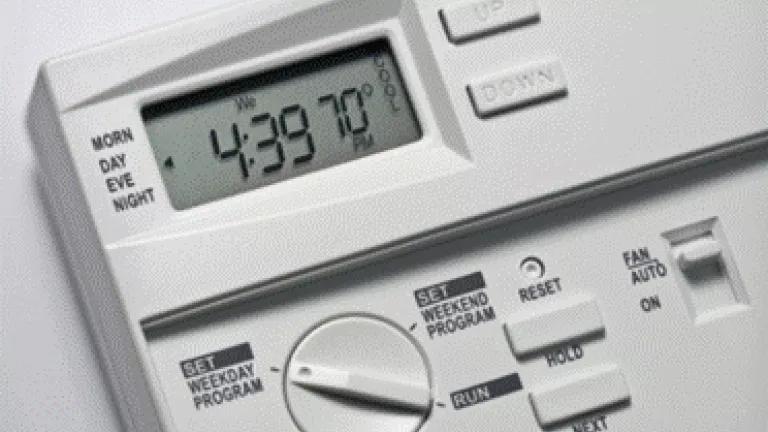
I wrote this entry with my colleague Allison Clements.
A federal appeals court in Washington, D.C. has handed a major setback to one of the cornerstone reforms for a cleaner, more intelligent and consumer-friendly grid. The U.S. Court of Appeals for the District of Columbia on May 23 invalidated a federal rule that allowed consumers to be paid a fair price for saving energy, typically at times of high demand or other stress on the grid when electricity prices are highest. Getting paid to reduce your electricity consumption and save energy is referred to as “demand response.”
FERC – the Federal Energy Regulatory Commission – issued the rule in question, known as Order 745, in 2011. In a nutshell, Order 745 requires customers who reduce their electricity demand in response to high prices in FERC-regulated electricity markets like PJM to get paid that price, which is the same price that power companies receive for producing power. In other words, instead of paying companies to generate electricity, the electricity markets pay some customers to reduce their use of power. (For this reason energy wonks like to think of demand response as providing “negawatts” for the grid in contrast to power supply “megawatts.”) By reducing the level of demand for power on the grid, demand response can reduce both overall electricity costs and pollution from power plants.
Notwithstanding demand response’s benefits, the association representing electric power suppliers and others sued FERC in federal court. They don’t like Order 745 mainly because demand response cuts into their revenue by lowering power prices. In court, they argued that Order 745 unlawfully intruded into the states’ jurisdiction to regulate demand response. In the decision issued today, two of the three judges on the court agreed with those objecting to the Order, although the third, Judge Harry Edwards, penned a lengthy dissent.
The court’s decision has potentially sweeping implications for consumers and policy makers because it could sharply limit the ability of FERC to develop important grid reforms. Equally worrisome, it could slow the pace of emerging markets and technologies that reduce pollution, increase grid reliability and lower consumer costs because people won’t find demand response such an attractive option.
Short legal analysis
The Federal Power Act (FPA) grants FERC jurisdiction to regulate power rates in the “wholesale” electricity markets such as PJM (Mid-Atlantic) and California ISO. Section 201 of the FPA limits FERC’s jurisdiction to markets and other areas not subject to state regulation. FERC had argued that it had jurisdiction over demand response under Section 206 of the FPA, which gives FERC the authority to regulate “practices affecting rates.” While the court in today’s decision agreed that demand response does affect wholesale rates, it also found that demand response is exclusively part of the state-regulated retail market because consumers make decisions about how much electricity to purchase through the retail market. The court therefore found that Section 201 of the FPA prohibited FERC from intruding into state jurisdiction.
Notably, the court said that FERC had failed to explain why its interpretation of Section 206 wouldn’t inevitably lead to FERC’s “almost limitless” regulation over “practices affecting rates,” such as steel, labor, fuel and other activities seemingly far removed from electricity markets. Yet, as Judge Edwards said in his dissent, it is hard to imagine a practice more directly affecting FERC-regulated rates than reducing electricity use, which unquestionably affects rates by reducing demand and lowering power prices in FERC-regulated markets.
Separately, the court found that even if FERC had the authority to establish compensation for demand response, the agency violated rules of “reasoned decisionmaking” (a legal term) by failing to consider and respond to arguments against its demand response compensation formula.
To be clear, the decision doesn’t mean that state-regulated demand response providers won’t be able to get paid something in FERC-regulated markets, but it does remove a key financial incentive – compensation at the full FERC-regulated energy market rate that generators receive – that motivates consumers to use demand response.
Implications for clean energy policy
Demand response contributes significant value to the electric grid. It provides reliability by balancing the grid’s power supply – it decreases the demand for electricity, especially during peak power periods when some of the dirtiest plants are forced to run to make up the supply gap. It is mostly clean because it represents actual reductions in electricity consumption which otherwise would be met by power plants. (In some cases, however, demand response isn’t so clean – such as when a company receives payments to reduce its use of grid power but then runs on-site diesel engines to generate replacement power.)
Demand response can also support the integration of wind and solar resources by smoothing out the variability in these resources’ output (like when the wind stops blowing or a cloud covers the sun). If consumers are reducing their use at the utility’s request, demand response also allows power plant owners to retire old, dirty coal plants that are losing money but staying online in case of high-demand emergencies.
The court’s decision implicates all of these important grid functions. Quite simply, at a time when the transmission grid and our electric resource portfolio are changing rapidly – think more solar and wind power, rooftop solar, electric cars and smart grid communications – the decision could seriously constrain FERC’s ability to reform grid rules to accommodate these new dynamics. Effectively, the decision would cement the agency into utilizing a 20th century approach to 21st century challenges.
What’s next?
FERC probably will ask the court to reconsider its decision, and if that is not successful it could appeal to the U.S. Supreme Court. If its appeals are unsuccessful, FERC probably will have to unwind the Order 745 requirements. In the meantime, opponents of demand response probably will use the court’s decision as ammunition to challenge other aspects of FERC’s regulation of demand response.

